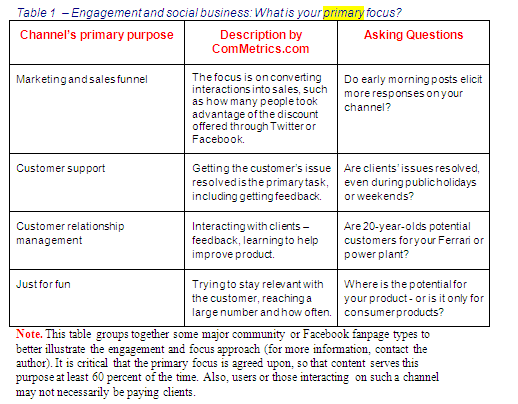Several weeks ago we launched the ComMetrics social media cost classification model (see also 2011 trends: The social media cost-benefit pyramid). Previous posts have addressed the social business maturity model, maintaining a high-quality Facebook page, and setting up a Facebook fanpage.
The feedback has been encouraging, so we decided to focus on how a Facebook fanpage could contribute to achieving social media impact and satisfactory ROI.
- Article source – Measuring Facebook impact: Focus and ROI
I recently came across a study of online shoppers visiting the top 40 US and UK retail websites who completed a survey about what influenced their visit to the website. The study reports some interesting data about the primary influencers for a retail (e-commerce) website visit.
Fully 38 percent noted familiarity with the brand and only 5 percent (3 percent in the UK) noted interaction on social networks as their main influence, suggesting that social networks may not be very effective in convincing people to purchase. Nevertheless, things may not be as they seem when evaluating this data.
For instance, thanks to familiarity one may have followed a particular brand’s Facebook page. Accordingly, while these data are interesting it is difficult to decide if they offer much insight. Along with our previous posts about Facebook cost accounting, this illustrates the necessity of figuring out the focus of one’s Facebook page.
Get the next of our series of posts about Facebook engagement, impact and ROI – and how to measure them – by signing up with your email:
- Exposure: Are we clear on what we want to expose our fans to?
Table 1 lists the four main types of channels that a Facebook page may be used for. It is pretty clear that all four options are open to a consumer brand. For a business-to-business (B2B) situation like an engineering firm, however, a Facebook page may be used for customer support and/or customer relationship management.

- Focus or be dead in the water
As a brand one must choose the type of Facebook page to offer and zero in on providing content that serves this purpose. While this will lower the number of fans, it is more likely to keep the ones who follow you engaged.
We rarely if ever sell to customers, but primarily B2B or industrial buyers and government agencies and have learned that customer support is not the ideal path for us. We focus more on customer relationship and information management, and while we sometimes get too few Likes or comments on a note left on Facebook, fans may still read the material.
- More resources
Bartholomev, Don. (December 30, 2010) Social media measurement 2011: Five things to forget and five things to learn. [Blog comment]. Retrieved March 15, 2011, from http://metricsman.wordpress.com/2010/12/30/social-media-measurement-2011-five-things-to-forget-and-five-things-to-learn/
Burke, Shonali. (September 1, 2010). Social media ROI v. impact: Don’t confuse the two [Blog post]. Retrieved March 15, 2011, http://www.waxingunlyrical.com/2010/09/01/social-media-roi-v-impact-dont-confuse-the-two/
- Influence and impact: What was your starting objective?
Calculating ROI is relatively easy if we have better cost control for our Facebook activities and cost effectively promote our brand on Facebook.
Note that context matters, just as location, location, location matters in real estate. A cult brand may have an easier time engaging, and statistics from other Facebook brand pages may not be that useful for performance comparisons.
As well, some measures we use are fine, such as getting impressions for a Facebook story, but they focus more on exposure than having an impact (e.g., changing people’s attitude toward your product). In both cases you need to set an objective that is measurable:
- Likes (Comments) per 1000 fans increased from 0.23 percent in Quarter 3 of 2010 to 0.40 percent by Quarter 3 of 2011
This is a properly stated and measurable objective that should indicate whether our impact is greater than it was last year, thereby indicating that people engage more with our content and product than they did before.
- Bottom line
Once we have defined what kind of channel we want to operate through our Facebook page, we need to think about how we want to measure our efforts’ improving influence and impact in social media marketing. With the help of better cost management we have moved a step further on the continuum to greater cost transparency.
An upcoming post will tackle this challenge in more detail – Measuring Facebook engagement: Understanding the audience
By the way, if you want to find more of our posts and white papers on this or any other topic, just enter a keyword and our name on your favorite search engine, such as ComMetrics Facebook engagement costs.
Okay, here are the questions I have for you:
- – What objectives have you set for your Facebook page?
– Does defining your channel and focusing on your target audience work for you on Facebook?
The comments, as always, are yours!
Pingback: commetrics
Pingback: milguy23
Pingback: World Economic Forum
Pingback: MyComMetrics
Pingback: CyTRAP
Pingback: commetrics
Pingback: milguy23
Pingback: Don Bartholomew
Pingback: Nabor Garrido Valle
Pingback: Nabor Garrido Valle
Pingback: Raquel Aguilar
Pingback: Héctor Espinoza
Pingback: wavesmcmx
Pingback: CyTRAP
Pingback: MyComMetrics
Pingback: Urs E. Gattiker
Pingback: World Economic Forum
Pingback: Urs E. Gattiker
Pingback: CyTRAP
Pingback: MyComMetrics
Pingback: EkVoice
Pingback: Emma Storbacka
Pingback: Romain El Hage